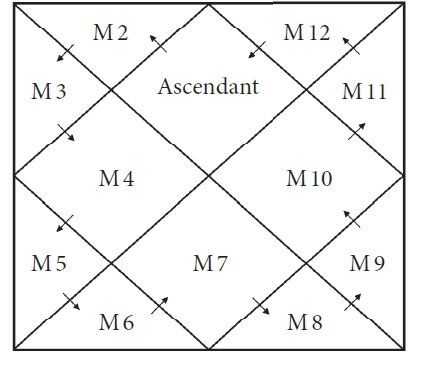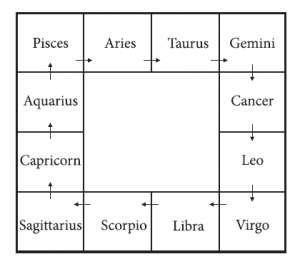 This chart is in the shape of a yantra (a mystical diagram), with diamond-shaped houses. The Ascendant (known as the Lagna in Sanskrit) is always located at the top central position of the chart. The houses are read counter-clockwise from the Ascendant. In this diagram, H2 indicates the 2nd house, H3 the 3rd house, and so on. The arrows indicate the direction in which the houses are read. Since the Lagna is always set for this format, the typical North Indian chart will have numbers in each house to show what sign of the zodiac resides in that house. The zodiacal sign that is rising is indicated by a number from 1 to 12: Number 1 is Aries, 2 is Taurus, 3 is Gemini, etc. through each of the 12 houses. Thus, if number 3 is in the Lagna, Gemini is rising and is assigned to House 1, Cancer to House 2, Leo to House 3. All North Indian charts are read like this, and the birth chart is typically shown to the left or above the Navamsha, the 9th harmonic chart.
This chart is in the shape of a yantra (a mystical diagram), with diamond-shaped houses. The Ascendant (known as the Lagna in Sanskrit) is always located at the top central position of the chart. The houses are read counter-clockwise from the Ascendant. In this diagram, H2 indicates the 2nd house, H3 the 3rd house, and so on. The arrows indicate the direction in which the houses are read. Since the Lagna is always set for this format, the typical North Indian chart will have numbers in each house to show what sign of the zodiac resides in that house. The zodiacal sign that is rising is indicated by a number from 1 to 12: Number 1 is Aries, 2 is Taurus, 3 is Gemini, etc. through each of the 12 houses. Thus, if number 3 is in the Lagna, Gemini is rising and is assigned to House 1, Cancer to House 2, Leo to House 3. All North Indian charts are read like this, and the birth chart is typically shown to the left or above the Navamsha, the 9th harmonic chart.
Category: Astronomy
How to read a South Indian chart
In this square chart the 12 zodiacal signs (known as Rashis in Sanskrit) are always in the same squares. The Dual signs are in the four corners. Pisces is always in the upper left hand corner, followed directly by Aries, then Taurus, and Gemini in the upper right hand corner. Virgo is in the lower right hand corner, Sagittarius in the lower left. The signs and houses are read clockwise around the zodiac. The Ascendant can be in any one of these 12 signs, and the planets distributed according to where they are in the heavens. All South Indian charts are read like this, and the birth chart is typically shown to the left or above the Navamsha (the 9th harmonic chart.)
COMMENT LIRE UN THEME DU SUD DE L’INDE
Dans ce thème en carré, les 12 signes zodiacaux (connus sous le nom de Rashis en sanscrit) occupent toujours les mêmes carrés. Les signes doubles se trouvent aux quatre coins. Les Poissons sont toujours en haut à gauche, suivis du Bélier, ensuite du Taureau et des Gémeaux dans le coin supérieur droit. La Vierge est au coin inférieur droit, le Sagittaire au coin inférieur gauche. Les signes et maisons se lisent dans le sens horaire. L’Ascendant peut se trouver en n’importe lequel de ces 12 signes et les planètes sont distribuées en Thème de l’Inde méridionale fonction de leur emplacement céleste. Toutes les cartes du sud de l’Inde se lisent ainsi, et le thème natal est affiché à gauche ou au-dessus de la carte Navamsha (la carte de 9ème harmonique).
Traduit de l’ouvrage d’Edith Hathaway In Search of Destiny: Biography, History & Culture As Told Through Vedic Astrology, 2012, p. 75.
COMMENT LIRE UN THEME DU NORD DE L’INDE
 Cette carte a la forme d’un yantra (diagramme mystique), avec des maisons en facettes. L’Ascendant (connu sous le nom de Lagna en sanscrit) occupe toujours une position centrale en haut de la carte. Les maisons se lisent en sens anti-horaire à partir de l’Ascendant. Dans ce diagramme, 2H montre la Maison 2, 3H la Maison 3, etc. Les flèches indiquent le sens de lecture de la carte. Puisque le Lagna est toujours ainsi établi pour ce Thème de l’Inde septentrionale format, un thème de l’Inde septentrionale comportera toujours un nombre pour montrer le signe du zodiaque correspondant à cette maison. Le signe qui se lève est indiqué par un nombre de 1 à 12 : à 1 correspond le Bélier, à 2 le Taureau, à 3 les Gémeaux etc., tout au long des 12 maisons. Donc si on a le nombre 3 au niveau du Lagna, c’est que le signe des Gémeaux se lève et qu’il est attribué à la Maison 1, le Cancer à la 2, le Lion à la 3. Tous les thèmes d’Inde septentrionale se lisent ainsi, et le thème natal est affiché à gauche ou en haut du Navamsha, la carte de 9ème harmonique.
Cette carte a la forme d’un yantra (diagramme mystique), avec des maisons en facettes. L’Ascendant (connu sous le nom de Lagna en sanscrit) occupe toujours une position centrale en haut de la carte. Les maisons se lisent en sens anti-horaire à partir de l’Ascendant. Dans ce diagramme, 2H montre la Maison 2, 3H la Maison 3, etc. Les flèches indiquent le sens de lecture de la carte. Puisque le Lagna est toujours ainsi établi pour ce Thème de l’Inde septentrionale format, un thème de l’Inde septentrionale comportera toujours un nombre pour montrer le signe du zodiaque correspondant à cette maison. Le signe qui se lève est indiqué par un nombre de 1 à 12 : à 1 correspond le Bélier, à 2 le Taureau, à 3 les Gémeaux etc., tout au long des 12 maisons. Donc si on a le nombre 3 au niveau du Lagna, c’est que le signe des Gémeaux se lève et qu’il est attribué à la Maison 1, le Cancer à la 2, le Lion à la 3. Tous les thèmes d’Inde septentrionale se lisent ainsi, et le thème natal est affiché à gauche ou en haut du Navamsha, la carte de 9ème harmonique.
Traduit de l’ouvrage d’Edith Hathaway In Search of Destiny: Biography, History & Culture As Told Through Vedic Astrology, 2012, p. 75.
COMMENT LIRE UN THEME DU NORD DE L’INDE
 Cette carte a la forme d’un yantra (diagramme mystique), avec des maisons en facettes. L’Ascendant (connu sous le nom de Lagna en sanscrit) occupe toujours une position centrale en haut de la carte. Les maisons se lisent en sens anti-horaire à partir de l’Ascendant. Dans ce diagramme, 2H montre la Maison 2, 3H la Maison 3, etc. Les flèches indiquent le sens de lecture de la carte. Puisque le Lagna est toujours ainsi établi pour ce Thème de l’Inde septentrionale format, un thème de l’Inde septentrionale comportera toujours un nombre pour montrer le signe du zodiaque correspondant à cette maison. Le signe qui se lève est indiqué par un nombre de 1 à 12 : à 1 correspond le Bélier, à 2 le Taureau, à 3 les Gémeaux etc., tout au long des 12 maisons. Donc si on a le nombre 3 au niveau du Lagna, c’est que le signe des Gémeaux se lève et qu’il est attribué à la Maison 1, le Cancer à la 2, le Lion à la 3. Tous les thèmes d’Inde septentrionale se lisent ainsi, et le thème natal est affiché à gauche ou en haut du Navamsha, la carte de 9ème harmonique.
Cette carte a la forme d’un yantra (diagramme mystique), avec des maisons en facettes. L’Ascendant (connu sous le nom de Lagna en sanscrit) occupe toujours une position centrale en haut de la carte. Les maisons se lisent en sens anti-horaire à partir de l’Ascendant. Dans ce diagramme, 2H montre la Maison 2, 3H la Maison 3, etc. Les flèches indiquent le sens de lecture de la carte. Puisque le Lagna est toujours ainsi établi pour ce Thème de l’Inde septentrionale format, un thème de l’Inde septentrionale comportera toujours un nombre pour montrer le signe du zodiaque correspondant à cette maison. Le signe qui se lève est indiqué par un nombre de 1 à 12 : à 1 correspond le Bélier, à 2 le Taureau, à 3 les Gémeaux etc., tout au long des 12 maisons. Donc si on a le nombre 3 au niveau du Lagna, c’est que le signe des Gémeaux se lève et qu’il est attribué à la Maison 1, le Cancer à la 2, le Lion à la 3. Tous les thèmes d’Inde septentrionale se lisent ainsi, et le thème natal est affiché à gauche ou en haut du Navamsha, la carte de 9ème harmonique.
Traduit de l’ouvrage d’Edith Hathaway In Search of Destiny: Biography, History & Culture As Told Through Vedic Astrology, 2012, p. 75.
Graha Yuddha: Testing the Parameters of Astrology and Astronomy
By Edith Hathaway
Copyright © 2003, Revised & expanded 2010.
Edith Hathaway is an international consultant (from 1980), author, teacher, and lecturer of Vedic astrology. Certified as Level IV Consulting Astrologer by the National Council of Geocosmic Research (1989), Master Astro*Carto*Grapher by Jim Lewis (1988), and Jyotish Kovid by the Indian Council of Astrological Sciences (1996), she is Senior faculty (from 1992) and Board member (1995-2010) of the American Council (& American College) of Vedic Astrology. Edith will lecture at the World Conference on Mundane Astrology, Oct. 1-4, 2010 in Vishakhapatnam, India. She will be featured speaker at the Washington State Astrological Association May 12 and 14, 2011 in Seattle, WA and a lecturer at the United Astrology Conference in May 2012 in New Orleans, LA. Her book In Search of Destiny: Biography, History, & Culture Told Through Vedic Astrology is due in 2011. See her website: www.edithhathaway.com. Continue reading

